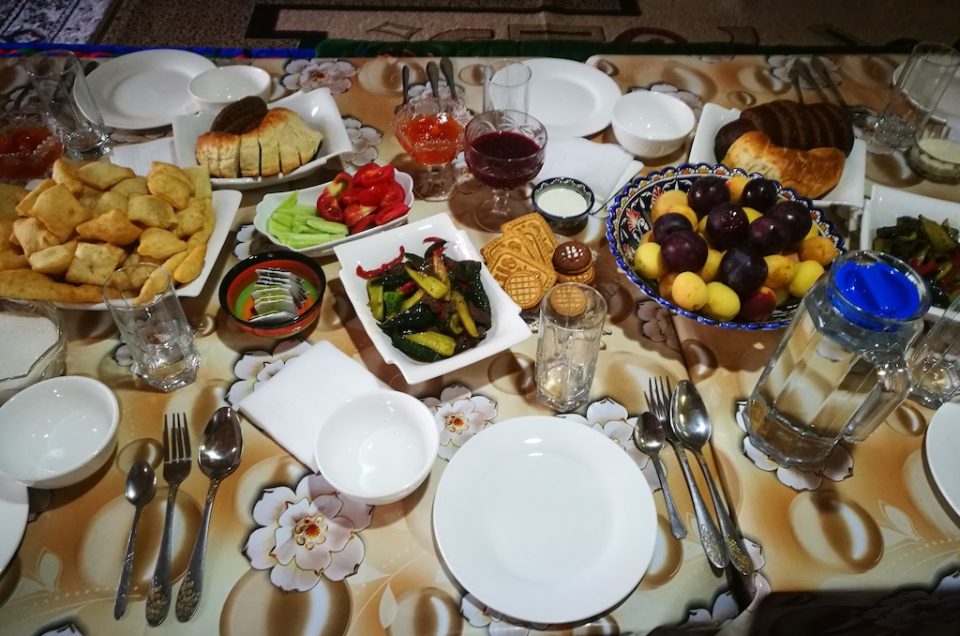
At meal time, the dastorkon, a tablecloth, is laid out on the ground or low table. It must be laden with food. A typical Kyrgyz table setting will have fresh cream, yoghurt, homemade jams, bread, nuts, seasonal fruits and copious amount of chay or tea.
Tea is served in small bowls called chini and filled only halfway to avoid the beverage getting cold and also leaving the option for more tea throughout the meal. You can add sugar or cream to your tea but if you want to fit with the locals, try putting in a dollop of jam into the tea. The jam gives the tea a delightful fruity flavour.
Sometimes guests will be offered kymyz, a traditional drink made from fermented mare’s milk, whilst it is Kyrgyz’s favourite drink, it definitely is an acquired taste for visitors unused to the sour-bitter taste. It is considered rude to refuse if you are offered kymyz, so just hold your breath and down it all.
Bread is central to Kyrgyz cuisine and it is served at every single meal. It comes in all shapes and sizes, from the fried puffy boorsok to the round crusty flatbread leproyska. Kyrgyz has a culture that has great respect for bread. Unfinished bread must be never thrown away. It is either reheated for the next meal or put out for the homeless to help themselves to it.
The meal usually starts with a small bowl of shorpo or meat and potato broth to warm up the tummy before the main meat dish, usually a stew like dimlama, a Turkic hearty dish of stewed meat, usually beef or lamb and potatoes, onions, cabbage and carrots.

Shorpo 
Shashlik
Another popular meat dish, not just in Kyrgyzstan but throughout Central Asia is the shashlik. These are skewered pieces of meat, usually beef or mutton, but sometimes of chicken or offal, cooked over a fire on a grill.
The dish, iconic of Kyrgyz cuisine is beshbarmak. Beshbarmak means "Five Fingers" in the Kyrgyz language, and is so called probably because the dish is typically eaten with the hands. It is a dish of meat, usually horse meat, boiled in its own broth and served over homemade noodles. This dish is typically served at feast for special occasions like celebration of a birth, weddings or funerals. The choicest pieces are offered to the elderly and guests first and the boiled head of the animal is reserved for the guest of honor. Side dishes to accompany the meat is usually a salad of simple cucumber and tomato or the national Kyrgz salad, shakarap, made up of tomatos and thinly sliced onion, flavoured with pepper, dill and basil.
In Kyrgyz cooking, wheat flour is used when making dough for noodles and dumplings.

Manti 
Samsa 
Laghman
Laghman is a delicious noodle dish, influenced by the Dungans, the ethnic Chinese Muslims. The texture of the noodles are not unlike spaghetti, and is cooked with meat and generous amount of mixed vegetables. Laghman can be served with a soup base or fried with added spices.
Dumplings are found in almost all types of cuisine, in Kyrgyzstan it is called manti – palm size dumplings filled with meat, onions and potatoes. Mantis are usually steamed but the fried version is also available. Very similar to the Indian samosas, the local samsas are delectable pockets of flaky pastry studded with sesame seeds and stuffed with meat and vegetables. Samsas are traditionally baked in a tandoor oven

Southern Kyrgyzstan’s cusine is influenced by its neighbouring country Uzbekizstan. The classic plov is a dish that represents hospitality and identity, no large dinner or celebration in the south would be considered complete without it. The plov consisting of rice, onion, carrots, peppers and meat are all cooked slowly in layers in a traditional cast-iron kazan (a large a semi-hemispherical metal pot that looks like a huge wok).
For desserts guests are offered more tea, cookies and an array of sweets and chocolates, readily available at the dining table.
The Kyrgyz people end the meal with a thanksgiving prayer, to which all at the table make the omin sign, passing both hands over their faces; a very respectful and heart – warming manner to leave the table.
